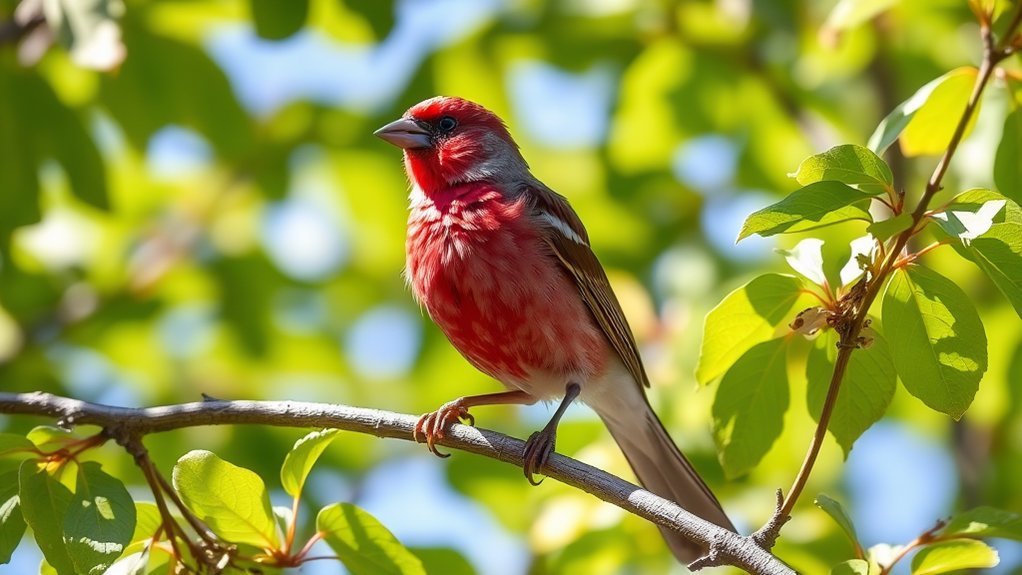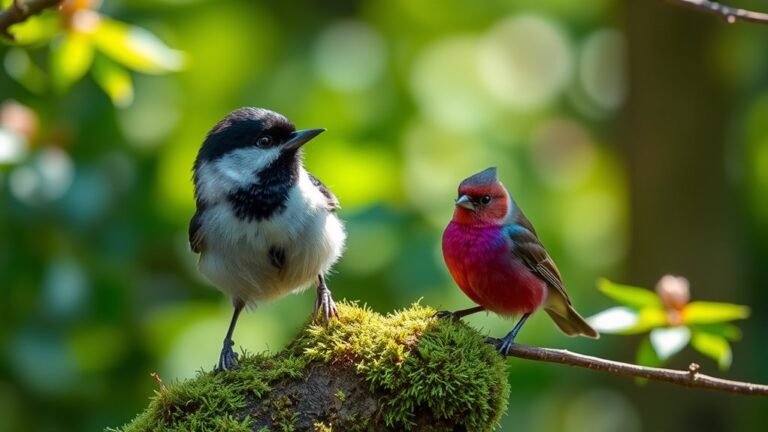Finches in Michigan: Identification and Behavior
In Michigan, finches show clear identification features and behaviors. The American Goldfinch, House Finch, and Pine Siskin have unique traits, such as bright colors and different feeding habits. Recognizing these differences helps us understand how they adapt to various habitats. However, these traits can lead to misidentification. To spot and enjoy these birds, let's look at their key characteristics and behaviors.
The American Goldfinch is bright yellow in spring and summer, with black wings and a cap. It eats seeds from sunflowers and other plants. This finch often forages in open fields and gardens.
The House Finch is more subdued, sporting brown and streaked plumage. You can find them in urban areas, feeding on a variety of seeds and fruits. They are social birds, known for their chirping songs.
The Pine Siskin has a streaky brown body with a slight yellow tint on its wings and tail. It prefers coniferous forests and feeds on small seeds. These birds often travel in flocks, making them interesting to watch.
By knowing these traits, we can better appreciate the finches in Michigan. Keep an eye out for their unique behaviors and enjoy observing them in their natural settings.
Key Takeaways
- American Goldfinches have bright yellow feathers in males during breeding season and produce soft, melodic songs.
- Common House Finches are found in urban areas. Males have reddish streaks on their heads and chests.
- Pine Siskins are brown with streaked plumage. They often travel in flocks and are known for their distinct chirping sounds and small, conical bills.
- Goldfinches like nyjer seeds, while House Finches prefer sunflower seeds. Offering a mix of seeds attracts a variety of finch species.
- Finches show unique feeding behaviors. They often hang upside-down to reach food, displaying their adaptability and social nature within flocks.
Overview of Finch Species in Michigan

Finches are an interesting part of Michigan's birdlife. Their various species provide insights into the area's ecosystems. Finches live in different habitats, such as urban gardens and large forests, which affect their behaviors.
For example, the American Goldfinch thrives in open spaces with wildflowers. It has a diet mainly of seeds and uses specific foraging strategies.
The Pine Siskin, on the other hand, prefers coniferous forests. It often forms social flocks, which helps it find and feed on seeds.
Watching these finch behaviors shows how they adapt and survive in their environments. Understanding their unique habitats helps deepen your appreciation for Michigan's biodiversity.
Engaging with finches can enhance your knowledge of how different species interact with their surroundings. This connection makes observing them enjoyable and informative.
Common House Finch: Identification and Habitat
The Common House Finch is a bird commonly found in Michigan. It's known for its ability to thrive in urban areas. This bird has a stout body and a conical bill. Males often have reddish streaks on their head and chest, making them easily recognizable.
House finches prefer to nest in protected spots like building eaves and hanging planters. Their nesting materials include twigs, grass, and sometimes items from humans, showing their adaptability.
These birds primarily eat seeds and fruits, which helps them succeed in city environments.
Watching their behavior can help you connect with local wildlife. The Common House Finch is a resilient bird that continues to adapt to its surroundings.
American Goldfinch: Characteristics and Behavior

The American Goldfinch is a small songbird known for its bright yellow feathers, especially in males during breeding season. You can find them in gardens, bringing joy to nature enthusiasts.
- They sing soft, melodic tunes that enhance summer days.
- They often hang upside-down while searching for seeds.
- Their diet mainly consists of thistle and sunflower seeds, showing their preference for high-quality food.
American Goldfinches are social birds. They usually travel in small flocks and interact playfully, creating a lively atmosphere.
Enjoy watching and listening to these charming birds!
Pine Siskin: Spotting Tips and Songs
How can you spot a Pine Siskin among common backyard birds? Look for an olive-brown finch with streaks, a sharp tail, and yellow wing bars.
They often feed in small flocks and move erratically, which helps you sharpen your observation skills. Listen for their lively chatter, which includes a mix of buzzing and twittering sounds. These sounds indicate excitement or alertness.
Pine Siskins frequently cling to feeders and peck seeds with agility. Recognizing these behaviors can help you connect with these birds and appreciate the variety in your backyard.
Purple Finch: Recognizing Their Features

To identify the Purple Finch, look for a few key features. They've thick, conical bills and bright raspberry-red coloring, especially in males.
Here are some points to aid in identification:
- Observe the light streaking on their bellies, adding a soft touch to their appearance.
- Listen for their unique, melodic song, which fills the woods during breeding season.
- Notice their rounded tails and wings, which reflect a gentle character.
When you see Purple Finches nesting, they often choose coniferous trees. Their nests are made from twigs and grasses, showing their building skills.
These qualities make the Purple Finch an interesting and memorable part of Michigan's birdlife, enriching our understanding of their role in nature.
Evening Grosbeak: Unique Traits and Preferences
You can easily spot the Evening Grosbeak by their bright yellow, black, and white feathers. Their colors create a striking appearance.
They also have unique calls that include soft whistles and sharp notes, helping you identify them among other birds.
Evening Grosbeaks mainly eat seeds from conifer trees and various fruits. Their strong bills allow them to crack seeds effectively.
Watching these birds can connect you with other nature lovers who admire their distinct features. Learning about their habits will deepen your appreciation for Michigan's diverse birdlife.
Crossbills: Identification Challenges and Distinctions
Crossbills have unique calls that often precede any visual sighting, but identifying them can be difficult. Their plumage varies, and they share similar traits with other birds.
Here are some tips for identifying crossbills:
- Look for their crossed beaks. These are used to extract seeds from conifer cones.
- Watch their flight. Crossbills tend to fly in an erratic, undulating manner, which can help you spot them.
- Pay attention to their colors. Males are usually more vibrant, while females have more subdued hues.
Listening to their distinct calls is also helpful for identification.
Finch Feeding Habits: What to Offer at Your Feeders
Finches display interesting feeding habits that you can enjoy. Goldfinches like nyjer seeds, while house finches prefer sunflower seeds and a mix of other seeds.
To attract different finch species, offer a variety of seeds in your feeders. This variety promotes healthier eating and makes birdwatching more enjoyable.
Location matters, too. Place your feeders near shrubs or trees. This provides finches with safety and easy access.
Choose spots with some cover to help them feel secure. Watching these birds eat can enhance your connection to nature and help you feel more in tune with your local environment.
Seasonal Migration Patterns of Finches
Finches migrate seasonally due to changes in climate and food resources. As food supplies decrease and temperatures drop, finches in Michigan typically travel south to survive the winter.
- Goldfinches stand out with their bright yellow feathers against the snow.
- Their calls echo through the cold air, creating a unique soundscape.
- Large flocks appear suddenly, moving instinctively together.
During winter, finches find shelter in warmer areas. They adjust to the needs of their environment.
Observing these migration patterns helps you connect with finches and enhances your enjoyment as a bird watcher.
Breeding Behavior of Michigan's Finches
As breeding season arrives in Michigan, finches take part in behaviors that support their reproduction and nest building.
Males perform mating rituals, which include singing and displays to attract females. These songs differ between species and show their genetic health.
After pairs form, finches create nests in safe places, usually in shrubs or trees. They use materials like grasses, feathers, and twigs to build their nests, placing them away from predators.
Watching these behaviors can increase your appreciation for finches and their strategies in Michigan's various environments.
Tips for Attracting Finches to Your Backyard
To attract finches to your backyard, create a welcoming space that resembles their natural habitat.
Start by placing feeders near dense shrubs or trees, as these provide both shelter and perching spots. Use nyjer (thistle) seeds or sunflower hearts in your feeders, as finches love these seeds.
- Use brightly colored feeders to catch their attention.
- Add shallow bird baths for drinking and bathing.
- Plant native flowering plants to attract natural food sources.
Common Misidentifications: Understanding Similar Species
While watching finches at your feeders, you may confuse them with other small birds. Two commonly misidentified species are the American Goldfinch and the Pine Siskin.
Both have yellow feathers, but the Pine Siskin displays streaked brown markings and has a smaller, conical bill. It generally has a quieter demeanor.
Observe their behaviors and songs to help with identification. The American Goldfinch sings a melodic, fluttering tune, while the Pine Siskin makes a series of chirping sounds.
Female finches can make identification tougher with their duller colors. Focus on distinguishing features like beak shape and tail patterns. This awareness enhances your birdwatching experience and connects you to local wildlife.
Frequently Asked Questions
What Types of Seeds Do Finches Prefer to Eat?
Finches prefer to eat nyjer seeds and sunflower seeds. They show skill when handling these seeds. This ability highlights their adaptability and feeding habits in different environments. Observing this can enhance your understanding of their dietary choices.
How Can I Tell Male and Female Finches Apart?
To tell male and female finches apart, look at their colors. Male finches usually have bright and vibrant colors. Female finches usually have more muted and dull colors. This difference helps in understanding their behavior and roles in mating.
Do Finches Migrate Alone or in Flocks?
Finches usually migrate in flocks. This behavior shows their social nature as they travel together. Some finches choose to migrate alone, which highlights their ability to adapt to different situations. Watching these migration patterns can help you learn more about their social structures and ecological roles.
How Long Do Finches Typically Live in the Wild?
In the wild, finches usually live between 3 and 11 years. Their lifespan can vary based on their species and surroundings. Important factors include their habitat, food sources, and the presence of predators. These elements play a significant role in determining how long finches can thrive in nature.
What Threats Do Finches in Michigan Face?
Finches in Michigan face serious threats from habitat loss and increased predation. As their natural habitats shrink, these birds struggle to find food and shelter. This struggle affects their survival and ability to reproduce. Protecting their environment is crucial for their well-being and future.

Kashvi is a passionate bird enthusiast and nature lover who has been fascinated by the world of birds for years. With a keen eye for detail and a love for learning, Kashvi is dedicated to sharing her knowledge and insights with fellow bird enthusiasts on Avian Enthusiasts. Through her engaging and informative articles, Kashvi aims to inspire others to join her in exploring the fascinating world of birds and to promote a deeper appreciation for these incredible creatures.







